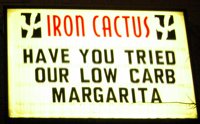SXSW04i Wrap-Up
Published 21 years, 9 months pastHaving taken some time to decompress, play with Carolyn, and generally recover from the trip, I present some thoughts, impressions, and memories gathered at SXSW04 Interactive.
- There’s still a lot of interest in social networking, and as much interest in doing it right. The attention XFN gathered (see D. Keith Robinson’s comments about hallway buzz) indicates that people want to make assertions about their social connections, and that they aren’t satisfied with the currently popular mechanisms for doing so.
- The interest in favelets/bookmarklets caught me totally off-guard; apparently, of everything I said in my ten minutes, the use of favelets for diagnostic purposes was the things that fascinated people the most. It’s easy to forget that such a simple thing can be unknown. I’ll be posting some of the ones I used in the near future, but in the meantime, you can’t go wrong with Tantek‘s favelets.com or Jesse Ruderman‘s Bookmarklets (“ancestors” is flat-out brilliant).
- Once I managed to pry him away from his fans
 , I chatted with Scott Andrew about the latest goings-on in the CSS world. I mentioned that Dave Shea and Doug Bowman are (deservedly) getting a lot of invitations to speak these days to cool events in other countries with travel expenses paid and everything. “That’s the rock star treatment,” said Scott. I groused a bit that I didn’t get that kind of treatment. He looked at me for a second and said, “Yeah, but you know, you’re the guy who’s been around forever and inspired all the new up-and-comers. You always get credited as an influence but you never get to the top of the charts. You’re basically the Neil Young of CSS.”
, I chatted with Scott Andrew about the latest goings-on in the CSS world. I mentioned that Dave Shea and Doug Bowman are (deservedly) getting a lot of invitations to speak these days to cool events in other countries with travel expenses paid and everything. “That’s the rock star treatment,” said Scott. I groused a bit that I didn’t get that kind of treatment. He looked at me for a second and said, “Yeah, but you know, you’re the guy who’s been around forever and inspired all the new up-and-comers. You always get credited as an influence but you never get to the top of the charts. You’re basically the Neil Young of CSS.” - I got a picture of Photo Matt as he was taking this picture. This fact amuses me completely out of proportion to its actual significance.
- The ratio of Mac laptops to everything else at the conference was about 10:1, maybe higher. I say “everything else” because I know of at least a couple of Intel-based laptops that were running Linux, not Windows. Brian Alvey came up with the idea of inventing a glowing Apple-logo sticker that non-Mac users could stick on their laptop lids in order to blend in.
- While standing outside the Webmonkey party, I saw a guy ride up on a bike with what looked like a heavy metal pole over his shoulder. He pulled to a stop, dismounted, and put his burden down while he locked up the bike. I was completely floored when I realized that he’d brought his own bar stool. Now that’s a self-sufficient man.
- I ended up at the Iron Cactus two nights in a row, and both nights I found myself shaking my head over the sign outside advertising low-carb margaritas.
 That’s right, folks, they take out the alcohol and pass the inflated profit margin on to you! It’s kind of a brilliant sales tactic, really, and I applaud them for overcharging customers in an honest yet sneaky way.
That’s right, folks, they take out the alcohol and pass the inflated profit margin on to you! It’s kind of a brilliant sales tactic, really, and I applaud them for overcharging customers in an honest yet sneaky way.
Frankly, the whole low-carb mania is starting to seriously tick me off, as it did Nick Bradbury; and yes, I know people for whom it’s worked. A cousin dropped 70 pounds and halved his cholesterol on Atkins, and my father has been very happy with the related South Beach Diet. That’s no excuse for the herd mentality I keep encountering. For example, Schlotzsky’s, whose sandwiches I love, now has low-carb options. How’s that work? They take away the distinctive sourdough bread (to use their own marketing phrase) and put the sandwich contents on a bed of lettuce. Um, isn’t that just a drastically overloaded salad?
 If I were in charge of Amazon.com or Wired or some other branded organization, there’s no way I’d replace the logo with plain text. Besides, an
If I were in charge of Amazon.com or Wired or some other branded organization, there’s no way I’d replace the logo with plain text. Besides, an 